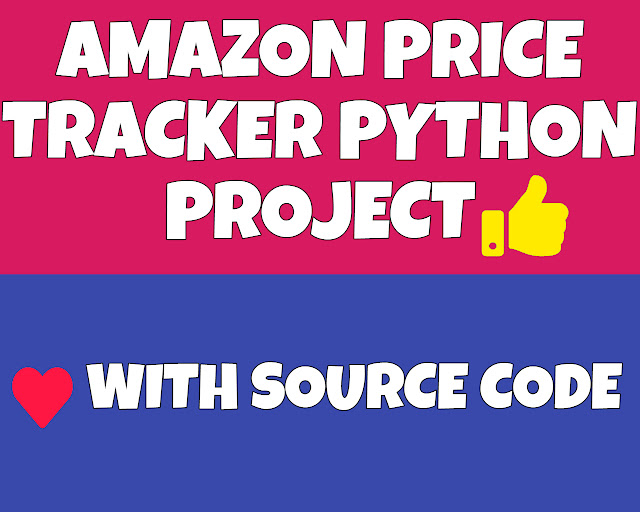In this project, you will also learn what web scraping is and how you can do web scraping because this project is on web scraping only.
What is the amazon price tracker project?
So guys, first we will understand the Amazon price tracker project then, We will understand how we can do this project.
In the Amazon price tracker project, we take input from the user that the URL of the favorite product of the user and he plans to buy when its price has gone down.
After taking that URL, We will Fetch the price, other details of that product by the URL.
We will give an excel report of that price and other details of that product and we will also run our program on schedule every 24 hours.
Then after running a program every 24 hours. we will compare after 24 hours price of the product and before 24 hours price of the product.
If there is a difference it means the price of that product went down or up and we will see if its price went down then there is an offer and if its price went up then there is no right time to buy that product.
Understand how we can implement code in python for the amazon price tracker project?
- The first step of the Amazon price tracker project is we have to take input from the user. We have to take the URL of the product that the user wants to buy when its price has gone down.
- After taking input from the user, our second step is to open that URL on the browser then Fetch the HTML of that page that was open in the browser then We have to target the HTML ID of that product details we can see the HTML ID of that product details by inspect element. Then we have to take the data of that ID in python.
- You can do this task by two popular libraries for web scraping: Requests and BeautifulSoup. Requests help to open URLs in the browser and BeautifulSoup helps to fetch HTML and fetch data of products by targeting the HTML ID.
- After getting data on that product we have to run that program every 24 hours and store the price of that product in one array.
- Then we will compare the last two prices of that array and if there is a difference on the last two prices in the array that means the price of that product is gone up or down.
- If the difference has come in positive numbers then it means its price has gone up and that is not the right time to buy that product and if the price has come in negative numbers it means there is an offer and it will right time to buy that product.
- After seeing if there is an offer or not we have to visualize the details and offers in the excel report. We can easily do this task with one library of python that is Pandas.
- This is important to give Excel reports because this is not the right way to show the details and offers on the python command prompt So, as a programmer you all have to maintain user experience while using that program.
- The last but not the least step is to run our python program every 24 Hours Because this step helps to see if there is an offer or not. This step can easily be done by the Time module.
Source Code:
# importing libraries
from bs4 import BeautifulSoup
import requests
import pandas as pd
import os.path
import time
prices = []
urls = []
addurl = 'y'
while 'y' == addurl:
Url = input('Enter Your URL: ')
addurl = input('If you want to add more URls Then type "y" else type any other key: ')
urls.append(Url)
f=0
while True:
data = []
for url in urls:
headers = {
'User-Agent': 'Mozilla/5.0 (Windows NT 10.0; Win64; x64) AppleWebKit/537.36 (KHTML, like Gecko) Chrome/58.0.3029.110 Safari/537.3'}
# Making the HTTP Request
webpage = requests.get(url, headers=headers)
print('Webpage founded')
# Creating the Soup Object containing all data
soup = BeautifulSoup(webpage.content, "lxml")
print('Webpage content founded')
title = soup.find(id="productTitle").get_text().strip()
print(title)
# categories = []
# for li in soup.select("#wayfinding-breadcrumbs_container ul.a-unordered-list")[0].findAll("li"):
# categories.append(li.get_text().strip())
# categories = [i for i in categories if i != "\u203a"]
# features = []
# for li in soup.select("#feature-bullets ul.a-unordered-list")[0].findAll('li'):
# features.append(li.get_text().strip())
try:
price = soup.select("#priceblock_ourprice")
price = float(price.replace('/xa', ''))
except Exception as e1:
price = soup.select("#priceblock_saleprice")
print(price)
# price = float(price.replace('/xa', ''))
review_count = soup.select("#acrCustomerReviewText")[0].get_text().split()[0]
availability = soup.select("#availability")[0].get_text().split()
space = ' '
availability = space.join(availability)
print('data founded')
lst = [title, price, review_count, availability]
df = pd.DataFrame(lst)
df = df.T
df.columns = ["title", 'price', "review_count", "availability"]
# print(df)
data.append(df)
print('print done')
prices.append(price)
print(prices)
n_prices = [prices[i:i+len(urls)] for i in range(0, len(prices), len(urls))]
offer = []
try:
price1 = n_prices[-2]
price2 = n_prices[-1]
res_list = []
for i in range(0, len(price1)):
res_list.append(price1[i] - price2[i])
for j in res_list:
if j < 0:
print('price was up')
offer.append('Costly')
elif j == 0:
offer.append('No')
else:
print('There is a sale')
offer.append('Yes')
print(offer)
except Exception as e3:
pass
data = pd.concat(data)
try:
data['offer'] = offer
except Exception as e4:
pass
a=1
try:
if os.path.exists("data.csv"):
raise FileExistsError
else:
data.to_csv('data.csv', index=False)
except Exception as e2:
while True:
if os.path.exists(f"data{a}.csv"):
a = a+1
else:
data.to_csv(f'data{a}.csv', index=False)
break
f = f+1
time.sleep(86400)






0 Comments
Hey, Thanks Forgive Interest in our article and Comment Us Freely. From Total Tech!! Thanks!!